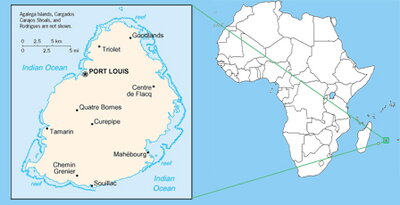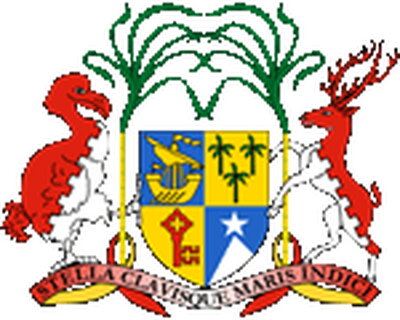

Region: Indian Ocean
Quick Facts:
- Population: 1.2 million
- Capital: Port Louis (also the largest city)
- Area: 788 sq miles. (About eleven times the size of Washington D.C.)
- Major Languages: English (official), French (official), Creole, Hindi, Urdu
- Life Expectancy: 69 years (men), 76 years (women)
- Literacy: 85.6%
- Monetary unit: 1 Mauritian rupee (MUR)=100 cents
- Exchange Rate: US $1= 32.3 MUR (March 17, 2007)
- Income (GDP) per capita: $11,141 (constant 2000 international $, WDI 2005)
- Urban population: 42% of total population
- Paved roads: 100% of total road surface
- Electric Power Consumption (per capita): 1579 kWH
- Fixed line and mobile phone subscribers: 700 per 1,000 people
- Internet Users: 146 per 1,000 people
- Internet Domain: .mu
- Country Code: +230
- Time Difference: UTC +4 (10 hours ahead of Illinois during Standard Time)
- Climate: Subtropical. Hottest month is January (84F), coldest July-August (68-74F)
- Type of Government: Republic
- President: Sir Anerood Jugnauth
- Prime minister: Navin Ramgoolam
Historical Background:
Mauritius was uninhabited when the Dutch took control in 1598 only to abandon it in 1710. It was then taken over by the French in 1715 and seized by the British in 1810.
Mauritius gained independence in 1968 as a constitutional monarchy, with executive power nominally vested in the British monarch and became a republic in 1992.
Socio-political Background:
Mauritian politics is conducted in the framework of a parliamentary representative democratic republic, wherein the Prime Minister is the executive head of government. Legislative power is vested in the government and the National Assembly.
Current Prime Minister Ramgoolam was elected in 2005 on the platform of tackling high inflation. As a result, he is a strong advocate of trade agreements that accord Mauritian exports, sugar and textiles in particular, a preferential status.
Mauritius enjoys a stable socio-political environment and has not been afflicted by political violence or civil war. Its economic success has ensured freedom from famine or other health epidemics and only one percent of its total population has tested HIV positive as of 2005.
Economy:
Since independence in 1968, Mauritius has developed from a low-income, agrarian economy to a middle-income diversified economy with growing industrial, financial, and tourist sectors. For most of this period, annual growth has ranged between five and six percent.
Sugarcane has traditionally been the largest component of national income and is still grown on about 90% of the cultivated land area, accounting for 25% of export earnings. The government's development strategy centers on expanding local financial institutions and building a domestic information telecommunications industry. Mauritius has attracted more than 9,000 offshore entities, many aimed at commerce in India and South Africa, and investment in the banking sector alone has reached over $1 billion.
The basis of the early growth of the economy, and the manufacturing sector in particular, was an import-substituting strategy for industrialization launched in the early 1960s. Priority was switched to export promotion through the introduction of export-processing zones (EPZ) in 1971.
The government has made a strong effort to promote the success of these EPZ. New investors in the sector agree to export all their output; in exchange, they are granted tax exemption for ten to twenty years, tax-free dividends for ten years, duty-free imports of raw materials and machinery, and low-interest loans. Industrial buildings are rented cheaply, and electricity and water are supplied at cost price. Textiles comprise 83 percent of the output produced in these EPZ.
Flowers, wood, furniture, paper products, and jewelry are the other major goods produced here. The European Union (74%) and the US (18%) are the two most important destinations of EPZ output.
Trade Information:
- Exports: $1.949 billion (2005 est.)
- Export Goods: Clothing and textiles, sugar, cut flowers, molasses
- Main Export Partners (2005): UK (32%), France (20.7%), US (11.7%)
- Imports: $2.507 billion (20005 est.)
- Import Goods: Manufactured goods, capital equipment, food items, petroleum products, chemicals
- Main Import Partners (2005): France (12%), South Africa (11%), India (7%)
While there are very few tariffs or other trade barriers in place in Mauritius, the 1998 Consumer Protection (Price and Supplies Control) Act monitors prices and supply of goods. There are two types of Price Control Mechanisms in Mauritius that affect certain goods:
- Consumer Goods in respect of which the maximum wholesale and retail prices have to be determined (Annex 5a of the Consumer Protection Act)
- Imported Commodities - Maximum Mark-up (Annex 5b of the Consumer Protection Act)
Resources for Businesses:
Embassy of the Republic of Mauritius, Washington, D.C.
4301 Connecticut Avenue, N.W., Suite 441
Washington DC 20008, USA
Tel: (202) 244 1491/1492
Fax: (202) 966-0983
E-Mail: MAURITIUS.EMBASSY@prodigy.net

Mauritius Chamber of Commerce and Industry (MCCI)
Royal Street, Port-Louis, Mauritius
Tel: (230) 208 3301
Fax: (230) 208 0076
E-Mail: mcci@intnet.mu
Basic Doing Business Information (MCCI)
List of Export Requirements (MCCI)
List of Import Requirements (MCCI)
Last updated on 04/15/2009